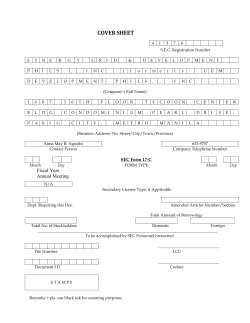
RESEARCH AT UEM: An overview
Conference on UEM Sweden Cooperation by P. Langa, D. Faife and B. Capece Stochkolm, 26th March 2015 Educação, Excelência e Inovação RESEARCH AT UEM: An overview Outline of the presentation • Introduc)on • Overview of some Research Performance Indicators • Challenges & Perspec)ves towards the new vision and mission Introduction • This presentation provides an overview of the state of affairs of research at UEM today § UEM was established in 1962; • For more than 5 decades it served the country as the main training ground for the cadres of the state apparatus, industry and society at large; • Intensive teaching to undergraduates has been its main role for many years; • With the growth of the HE System and establishment of more than 50 new institutions, UEM intends to focus more on research and therefore becoming a research-led university to better fulfil its role in society; • . Brief overview of some research perfomance indicators (1/4) Academic staff by degree 2013/2014 Doctorate Masters Bachelors Hons Total 352 807 521 1680 21% 48% 31% 100% Research at UEM is fundamentally secured by PhDs, Master’s and BA Hons through various research projects, particularly related to their own academic training. Most of the staff is also intensively engaged in teaching particularly at undergraduate level. However, post-graduate training is increasing gradually. Brief overview of some reseach perfomance indicators (2/4) Academic staff by seniority at UEM 2013/2014 Associate Professor Assistant Professor Lectures Total Number 14 83 176 1407 1680 Percentage 1.0% 5% 10% 84% 100% Category Full Professor Brief overview of some reseach perfomance indicators (3/4) Academic staff by seniority in 8 african Flagship Universities Brief overview of some reseach perfomance indicators (4/4) Academic staff by seniority in 8 african Flagship Universities in 2013 Post-graduate studies at UEM ProporEon of Post-‐graduate programs in 2013 Doctoral Masters Under-‐graduate Total PROGRAMS 03 52 135 190 Percentage 2% 27% 71% 100% STUDENTS 23 2527 31.885 34.435 Percentage 0.1% 7.3% 92.6% 100% 6 80 1902 1988 0.4% 4.% 95.6% 100% GRADUATES Percentage Doctorate⁄Master= 1⁄110 Ratio of master to doctoral students in 2011 Source: complied by Buntin, 2014, Publication by Academic Unit-2013 FAVET FMED FLCS FC FAEF FACED CEA FENG ESHTI ESCMC CEISA ESNEC FAPF ESUDER Total 45 55 44 24 33 29 22 5 5 13 6 2 283 12 26 40 28 16 9 3 11 1 3 2 13 164 Product /Service 19 6 36 28 15 19 3 1 8 135 Educação, Excelência e Inovação Organic Unit Publications Communications Educação, Excelência e Inovação Peer-reviewed research publications: 2001-2011 Source: complied by Buntin, 2014 Educação, Excelência e Inovação Annual trends in publication outputs of african flagship universities (1996-2013) Educação, Excelência e Inovação Largest research field of international cooperation (2006-2012) Compiled by Robert Tijssen Source: CWTS/Thomssons Reuters Web of Science database Publications vs Projects (2011-2013) 140 120 Nr. of publicaEons MED FLCS FAEF 100 CEA 80 VET FC 60 40 20 FAPF ESHT 0 FIL FD 0 FACED 20 40 60 Nr. of projects 80 100 120 Ratio of the state budget allocated to research and the number of academic staff/researcher (MZN/ SEK) 946.8 473.6 189 189.7 208.8 77.8 Source: UEM data, G. Plan, 2013 YEAR 140.2 Main sources of donor research funding to UEM 2008 - 2013 Source: Annual Report, G. Plan, 2013 Educação, Excelência e Inovação Extension to which universities met Flagship average targets - UEM 2009-2011 Some challenges and action plan towards the new vision and mission of becoming a research led university i. Strengthen the research capacity and institutional research culture; ii. Improve access to research funding through diversification of sources and promotion of competitive funding; iii. Establish center's of excellence in research with national and regional impact through research partnerships; iv. Establish a scientific park at UEM equipped with high profile multifunctional research laboratories; v. Incentivise the establishment of research groups within the various units; vi. Create research and dissemination incentives vii. Establish trans and interdisciplinary research lines; viii. Promote academic mobility including both staff and students exchange; ix. Increase Doctoral programmes (exploring Joint, double and interinstitutional degrees) Educação, Excelência e Inovação THANK YOU
© Copyright 2025












